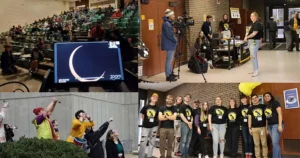With the 100-year anniversary of the invention of the Planetarium, a famous astronaut visiting the UWM campus, and a partial solar eclipse, this fall semester has been truly stellar at the UWM Planetarium.
To celebrate the centennial of the first planetarium projector built, the Planetarium team hosted a party in October with more than 150 people who came to celebrate with UWM. Student staff members described it as “such a moment of comradery of space lovers all around.”
During her Distinguished Lecture on Oct. 10, Dr. Mae Jemison, the first Black woman in space, shared her career milestones and what she sees for the future of humanity. Viewers described her as a “hero with an inspiring outlook of humanitarian needs.” Meeting her was a dream come true for Planetarium director Dr. Jean Creighton.
Wisconsin weather does not stop the hardy folks at the Planetarium. Even though it was a cloudy day, dozens of people watched the solar eclipse on Oct. 14 live from NASA in one of the lecture halls. Planetarium presenter Jack Koshkin, who ran the live stream, said, “At the moment of totality, everyone cheered, and it was such a heartwarming response.” A TV crew interviewed one of our Planetarium staff members, Autumn Carroll, helping the Planetarium staff share the excitement of the eclipse with viewers in the southeast Wisconsin area.
The Planetarium staff wouldn’t have been able to do this without the support of campus partners. The UWM College of Letters & Science provided the Planetarium with the funding to purchase 10,000 solar eclipse glasses, which were handed out at the Planetarium and other venues for people to safely see the eclipse wherever they were. In addition, Physics professor Philip Chang secured funding from the National Science Foundation for both eclipses, including the April 8, 2024 solar eclipse. Don’t miss Planetarium events before and during April. You will have to wait until 2044 before we see another eclipse in this region.
Courtesy of the UWM Planetarium
